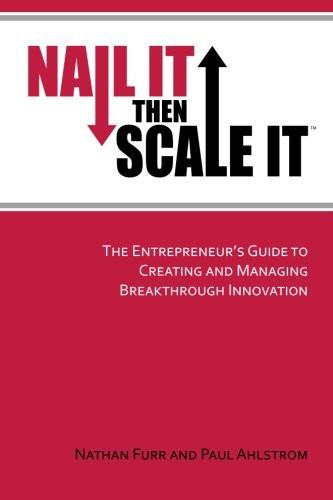Aiden Mejia's Key Ideas from Nail it Then Scale it
by Nathan R. Furr, Paul B. Ahlstrom
Ideas, facts & insights covering these topics:
30 ideas
·30K reads
95
Explore the World's Best Ideas
Join today and uncover 100+ curated journeys from 50+ topics. Unlock access to our mobile app with extensive features.
The Three Myths of Entrepreneurship
- The hero myth - What does it take to be a successful entrepreneur? We all hear the same list of qualities: passion, determination and vision. But the same qualities that are heralded as traits of the successful may lead to your startup’s demise.
- The process myth - The conventional, "build it and then sell it" process doesn't work because entrepreneurs start out with a guess.
- The money myth - More money isn't necessarily better. Investment removes the constraint of entrepreneurs needing to focus obsessively on what customers want. it enables you to pursue flawed business plans.
324
2.71K reads
Core Principles of NISI (Nail It Then Scale It)
- Get out into the field - Get out of the building, outside the company, outside your circle of friends... validate assumptions like scientists. Don't be attached to your vision.
- Fail fast and embrace change - Do not waste time pursuing an idea that's not a true opportunity; fail fast. Be dispassionate enough to let go and move on.
- Adopt the attitude of learning - The attitude of learning will enable you to successfully discover real opportunities.
- Test your guesses with rapid, inexpensive, simple experiments - Don't start building without testing your guesses.
363
2.28K reads
Cognitive flexibility
It is the ability to recognize new information and then change the way you view the world. It can help you be more agile and beat out your competitors who are stuck in the old way of doing business.
321
2.07K reads
Motivation Trap
Sunk cost leads to irrational decision-making. when entrepreneurs stake their hopes and dreams on a startup, the resulting motivation can make it all but impossible for them to learn in an intellectually honest way - overconfidence trap: research shows experienced individuals tend to be overconfident in their judgement and ability to control the uncontrollable. stay determined but be humble along the way.
311
1.74K reads
Familiarity Trap
Recognize our weaknesses and blind spots. We tend to try and reuse ideas from other settings that may not be appropriate. For example, A CEO with a marketing background may see the world through the lens of the "go big" marketing blitz strategy.
304
1.59K reads
Tips For Starting Out
- Become an "expert-novice": hold knowledge and confidence, but always maintain a seed of doubt and thirst for more knowledge.
- Reframe your startup's purpose: reframe the purpose of your venture to be learning about what the market wants, rather than proving that your idea works. this mental trick helps you avoid learning traps and focuses you on learning.
- Seek a high volume of feedback: feedback helps correct overconfidence, increase pattern recognition, and help us see the truth.
- Be data-driven: don't rely on beliefs and gut feelings. base decisions on data — even if it's limited data.
333
1.3K reads
Phase 1: Nail the Customer Pain
The goal of this phase is to clearly define and understand the customer pain and determine whether the customer pain is a market opportunity.
The test of nailing the pain is whether customers return your cold calls. In this first step, we want to answer the question "Is this a pain worth solving?"
No pain, no business.
319
1.19K reads
Steps To Nail Customer Pain
- Write down a monetizable pain statement - A monetizable pain represents a pain that customers recognize, have money to pay for, and are overly interested and eager to solve.
- Write down a big idea hypothesis - An idea for a solution to the pain you observed, specific to the customer group, and why it is different from existing solutions.
- Test your hypotheses - Be quick about it.
318
1.01K reads
The 50 Percent Rule
If 50% of customers return your call, you have found the monetizable pain and a potential beachhead for your product.
If it is less than 50%, the low response rate may mean that you just haven't found the right customer niche or the right words to describe the pain to the customer. By talking to the customers who do respond, you can find clues about where to find the real monetizable pain.
322
982 reads
Evaluating The Pain
Once you've validated a customer pain, it's time to ask yourself "how big is the pain I'm trying to solve and is it worth it?"
Many entrepreneurs we have talked to discover a customer pain, build a solution for the pain and then realize after the fact that they are actually tackling a rather small market.
Evaluate:
- Market Size
- Market Growth - A rising tide lifts all ships.
- Competition - What differentiates you?
- Laws & regulation
- Sales cycle
313
826 reads
Phase 2: Nail the Solution
In this stage, you cultivate a minimum feature set that you develop iteratively while validating with customers.
As you iterate, in addition to refining the solution based on customer feedback, you should be improving your understanding of the market and defining the best segment for an initial beachhead. As much as possible, you should try to find new samples of customers to gain fresh, unbiased perspectives.
306
784 reads
Steps To Nail The Solution
Write down a MFS Hypothesis
The minimum feature set represents the smallest, most focused set of features that will drive a customer purchase. There are a few tests that can be conducted:
- Test 1: The Virtual Prototype Test
- Test 2: The Prototype Test
- Test 3: Solution Test
310
747 reads
"Since only one in every five to ten ideas works out, the strategy of limiting the time we have to prove that an idea works allows us to try out more ideas, increasing our odds of success."
MARISSA MAYER
308
804 reads
Discuss potential solutions with customers
Detach yourself from your biases, get on the customer's side of the table, look at the problem from their perspective, and make them feel that you truly want to learn how they feel about this problem and potential solutions
Do you have this problem? Does this solution solve your problem? What would the solution need to have, for you to purchase it?
311
636 reads
The Prototype Test
- Develop an inexpensive, rapid prototype — something your customers can use and give them a picture of the solution you are proposing.
- Be resourceful — ask suppliers for samples. Find partners. Avoid investment.
- Prototype Road Show - Test your prototype in front of full buying panels of customers.
- $100 game - ask yourself if you had $100 to invest in any features of this product, what features would you invest your money in
312
627 reads
Testing The Price Point
The price your customers are willing to pay is the measure of the degree to which you have nailed the solution.
Breakthrough questions:
- "How much would you expect to pay or a solution like this?"
- "Would you be willing to prepay for this product?"
- "Would you be willing to purchase this today?"
- "If I gave this to you for free, would you install it today system-wide?"
318
587 reads
Solution Test
Partner with your customers, usually through a pilot program, to take your solution through a final round of iteration to refine it into the solution customers want. At this point, your customers should be willing to begin paying for the product. You should begin closing paid pilots or be selling your product.
If customers won't pay now, they probably won't pay later. While it's natural to shy away from or defer asking for payment, we're only avoiding the truth and doing ourselves harm.
306
532 reads
Phase 3: Nail the Go-To-Market Strategy
The goal is to understand the process by which customers find out about and decide to purchase our product and to use our findings to develop a repeatable sales model and optimize our marketing and sales strategy. We should be continuing to explore and validate price points while closing paid pilots, nurturing early-stage customers, and turning them into evangelists.
We should validate our go-to-market assumptions with paying customers.
306
518 reads
Map the customer-buying process
The customer buying process is the map of your customers' activities from the moment they find out about your product through the purchase and use to the ultimate disposal of your product.
It is defined by the job your customer is trying to get done and all the relevant activities that surround that job. To uncover this, ask customers about how they accomplish or try to complete that "job" with any relevant solutions, from beginning to end.
304
472 reads
Develop a Sales Model
Look for leverage points within the buying process at which you can influence customers' purchase decisions.
Example: Apple didn't just revolutionalize the sale of MP3 players by making a better MP3 player. They also reinvented the entire buying process for digital music, which before iTunes was difficult and overwhelming. This opened up a segment of customers who previously had shied away from purchasing digital music and MP3 players.
307
494 reads
Defining a Market Infrastructure Strategy
- Map the key categories of the market infrastructure
- Identify the top three partnerships in each category
- Understand the motivations and needs of each player
- Create measurable and time-bound objectives for each potential partner and a strategy to leverage the infrastructure based on your interactions with customers
- Assign an owner to each partner
304
473 reads
Pilot-Customer Development
Close and launch paid pilot-customer relationships and utilize them to refine the product, go-to-market strategy, and serve as references.
If you properly nurture reference customers, at the end of the pilot you will have a robust solution, a deep understanding of your go-to-market strategy, and a reference for future sales.
301
460 reads
Phase 4: Nail the Business Model
- Your business model is the map of how you create value and deliver it to customers. In this phase, we will conduct financial analysis to verify business viability, launch your product and go-to-market strategy, and then develop a dashboard to monitor your progress forward.
- Predict Business Model with Customer Data: Ask questions like "how would you want to buy something like this?" direct, distributor, partner. What would they need to feel comfortable making the purchase? What would a potential deal look like?
- Validate Financial Model: Evaluate margins, fixed costs and variable costs.
306
421 reads
Phase 5: Scale It
The very process of growing will change your company in fundamental ways that will make what you did in the early days obsolete in the later days.
The process of "nailing it" is recursive.
As startups grow, the nature of how they operate begins to change. As a company grows, a shift occurs from facing an unknown problem/solution at the onset, which required radical exploration, to facing a known problem/solution that requires execution. As a company gets bigger, the nature of what it has to do to be successful changes.
303
408 reads
New Markets
New markets are created by a disruptive technology that serves new customers or an opportunity that was previously unnoticed or underserved. Whether or not it is a new market doesn't necessarily depend on your technology or product, but rather how the technology or product is applied. For example, a 1.3-inch hard drive in the PDA market (established market) vs the video-game market (new market).
New markets are high-risk, high-reward. They are dangerous for startups because you are exploring uncharted territory, defining a new category, educating consumers, and trying to change behaviours.
301
403 reads
Established Markets
Established markets are markets where products exist and where you intend to compete by offering a product that serves a niche within the existing market or is a complement to an existing product.
Consider attacking the low end of the market first. Customers at the top of the market aren't willing to risk their business on an unproven startup. In contrast, customers who are fighting the big players in the industry are constantly looking for an edge and are more willing to work with a startup that could give them an advantage.
303
388 reads
Crisis And Focus
Many investors and entrepreneurs will admit that most successful companies faced a crisis before they succeeded.
The value of a good crisis is that it forces you to focus and renew your commitment to make the time to really nail the product and reshape the company.
304
401 reads
Avoid becoming a Model, Packrat, or Junkie
- Models - intelligent, well-spoken, credentialed. pays lip service to the process but under the surface believe they already have the answer.
- Packrats - chases down and tries to satisfy every last customer. unable to fire the customers that distract from the real value proposition.
- Junkies - focus all of their energy on pleasing investors and bankers instead of focusing on the customer and building real value.
308
424 reads
Branding
When it comes to the image you create as a startup, once you start selling, go big or stay home within the niche you have targeted. This doesn’t mean you have to burn all your capital, but you do want to communicate that you are established and reliable when you start trying to capture the early majority. For my time at Knowlix, this meant spending the money to obtain a moderately central space at the tradeshow their customers attended, creating a professional booth, and then pulling out all the stops to establish buzz around the booth.
301
411 reads
IDEAS CURATED BY
CURATOR'S NOTE
This book will teach you how to create your own startup, nail the problem it solves, and scale it.
“
Aiden Mejia's ideas are part of this journey:
Learn more about moneyandinvestments with this collection
How to overcome fear of rejection
How to embrace vulnerability
Why vulnerability is important for personal growth
Related collections
Different Perspectives Curated by Others from Nail it Then Scale it
Curious about different takes? Check out our book page to explore multiple unique summaries written by Deepstash curators:
12 ideas
Anup Chouhan's Key Ideas from Nail it Then Scale it
Nathan Furr, Paul Ahlstrom
Discover Key Ideas from Books on Similar Topics
Read & Learn
20x Faster
without
deepstash
with
deepstash
with
deepstash
Personalized microlearning
—
100+ Learning Journeys
—
Access to 200,000+ ideas
—
Access to the mobile app
—
Unlimited idea saving
—
—
Unlimited history
—
—
Unlimited listening to ideas
—
—
Downloading & offline access
—
—
Supercharge your mind with one idea per day
Enter your email and spend 1 minute every day to learn something new.
I agree to receive email updates



